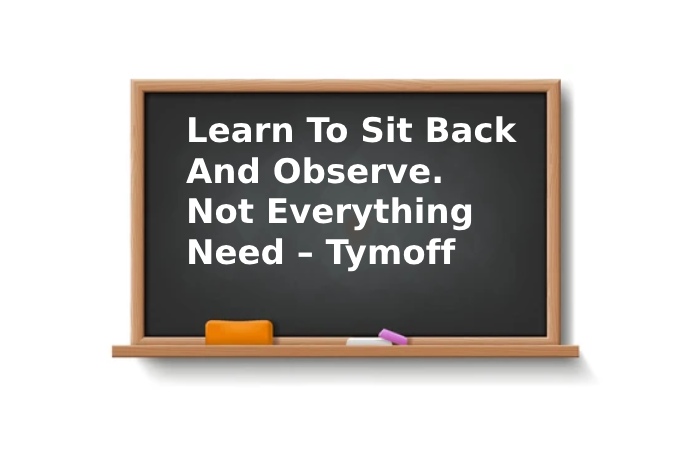In our fast-paced world, the need digital age bombards us with information, opinions, and events that demand immediate attention and response. However, there’s immense wisdom in the simple practice of Learn To Sit Back And Observe. Not Everything Need – Tymoff principle is a reminder that sometimes, the best action is inaction.

Understanding the Principle What “Not Everything Need – Tymoff” Means
The phrase “not everything needs – tymoff” suggests that not every situation requires immediate intervention or constant attention. Tymoff, as a concept, implies a need to disengage or take a break. Embracing this principle means knowing that, occasionally, the best course of action is to allow situations to unfold naturally rather than striking our will upon them. This approach can decrease stress and stop burnout by accenting the importance of strategic withdrawal and mindful engagement.
The Art of Observation
Learning to sit back and observe is an art that can alter how we interact with the world. It involves stopping, stepping back, and giving ourselves the space to understand situations fully before jumping to conclusions or choices. This approach is particularly beneficial in both individual and professional settings.
In personal relations, for instance, misunderstandings often arise from hasty reactions. Observant before responding allows us to see the bigger picture, understand the other person’s perspective, and reply more considerately. This can main to more meaningful and less conflict-prone interactions.
The Benefits of Observation
Enhanced Understanding
When we take the time to detect, we gain a deeper understanding of circumstances and people. This can main to healthier relationships and more real problem-solving.
Improved Decision-Making
Observation allows us to gather more information before making decisions. This leads to choices that are well-informed and likely to be more successful.
How to Practice Observation?
Mindfulness Techniques
Mindfulness is a powerful tool for enhancing observation. We can notice details we might otherwise miss by being present at the moment.
Active Listening
Active listening involves fully intent on what is being said rather than just inertly hearing the message. This practice can greatly improve our observational skills.
Embracing Tymoff’s Principle

To truly embrace the principle that not everything needs action – Tymoff encourages us to cultivate mindfulness and patience. Mindfulness helps us stay current and fully engaged with the moment, while patience allows us to wait for the right time to act. These qualities enable us to navigate life’s complexities with greater wisdom and composure.
Incorporating this mindset into daily life can start with simple practices. Begin by setting aside time each day for reflection, whether through journaling, meditation or simply sitting quietly. Pay attention to your impulses and practice delaying immediate reactions. Over time, you’ll find that this approach leads to more thoughtful and effective actions.
Tips for Effective Observational Sitting Back
Adopting the appropriate observational mindset is important to reap the rewards of sitting back without intervention. Here are some tips for engaging in effective observational sitting back:
Adopt a non-judgmental stance: Resist the urge to evaluate or criticize what you observe immediately. Try to understand without assigning labels “good” or “bad.”
Notice details without internal narration: Quiet the internal monologue and pay attention to what is happening before you rather than mentally commenting as an observer.
Use all senses Absorb: Your environment visually, but also listen for sounds, notice smells, and pay attention to feelings in your body. Engage fully with observation.
Suspend preconceptions: Be open and resist imposing your assumptions or expectations on a situation. Let it teach you rather than judge it through your existing lens.
Be fully present: Commit to observing in the moment rather than having side thoughts or distractions. Give full attention without multitasking mentally.
Find stillness within activity: Even when watching busyness, maintain inner tranquility rather than feeling frenzied. Keep your peace.
Notice repeating patterns: Track motifs, habits, or typical behavior over time to understand deeper consistencies one moment cannot provide.
Surrender needs to fix everything: It is back from the mentality of always needing to solve problems or intervene immediately. Relax into receptive watching.
By adopting an open, non-reactive stance of quiet observation, we permit ourselves to thoughtfully learn from our environment rather than always feeling driven to manage it perimetrically. This benefits both inner growth and outer understanding.
Conclusion
Learn to sit back and observe in a world that often glorifies constant Learn To Sit Back And Observe. Not Everything Need – Tymoff principle teaches us that sometimes, the best way forward is to pause, observe, and wait for the right moment. We can enhance our relationships, professional effectiveness, and overall well-being by embracing this approach. So, next time you feel the urge to react, remember to step back and observe. You might be surprised at the clarity and wisdom it brings.
Helpful Resource: BP Groeit, Benzine, Climate Goals, Brandstof,


